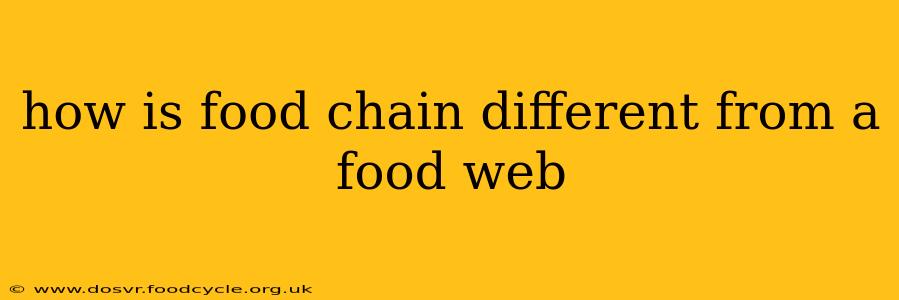Understanding the difference between a food chain and a food web is crucial to grasping the complexities of ecosystems. While both illustrate the flow of energy and nutrients through an ecosystem, they do so at different levels of detail. This article will clarify the distinctions and explore related concepts.
What is a Food Chain?
A food chain is a linear sequence showing how energy and nutrients move from one organism to another. It typically starts with a producer (like a plant) and progresses through a series of consumers (herbivores, carnivores, omnivores). Each organism in the chain represents a trophic level, representing its position in the food chain. For example, a simple food chain might be: grass → grasshopper → frog → snake → hawk. This linear representation simplifies the complex reality of ecological interactions.
What is a Food Web?
A food web is a more realistic and complex representation of the feeding relationships within an ecosystem. It's essentially a network of interconnected food chains. Instead of a single linear path, a food web shows how multiple organisms at different trophic levels interact with each other. An organism may be a part of several different food chains, feeding on multiple prey and being preyed upon by multiple predators. This interconnectedness creates a more accurate picture of the ecosystem's dynamics. Think of it as a multitude of food chains intertwined, forming a web-like structure.
How are Food Chains and Food Webs Different?
The key differences can be summarized as follows:
| Feature | Food Chain | Food Web |
|---|---|---|
| Structure | Linear sequence | Interconnected network of food chains |
| Complexity | Simple, simplified representation | Complex, realistic representation |
| Interconnections | Organisms have only one predator and one prey | Organisms can have multiple predators and prey |
| Accuracy | Less accurate depiction of ecosystem | More accurate depiction of ecosystem |
What are the Components of a Food Chain and Food Web?
Both food chains and food webs are built upon the same basic components:
- Producers: These are autotrophs (usually plants) that produce their own food through photosynthesis. They form the base of the food chain/web.
- Consumers: These are heterotrophs that obtain energy by consuming other organisms. They are categorized into:
- Primary consumers: Herbivores that eat producers.
- Secondary consumers: Carnivores or omnivores that eat primary consumers.
- Tertiary consumers: Carnivores that eat secondary consumers.
- Apex predators: The top predators in a food chain/web, with no natural predators.
- Decomposers: Bacteria and fungi that break down dead organisms, returning nutrients to the environment. These are often omitted from simplified food chain diagrams but are crucial to the ecosystem’s overall health.
What are Trophic Levels?
Trophic levels represent the feeding levels in a food chain or web. Producers occupy the first trophic level, primary consumers the second, and so on. The transfer of energy between trophic levels is not perfectly efficient; a significant portion is lost as heat at each step.
Why are Food Webs More Realistic?
Food webs are more realistic because they reflect the interconnectedness and complexity of natural ecosystems. In reality, organisms rarely have only one source of food or only one predator. Food webs better illustrate the consequences of disruptions, such as the removal of a key species, showing how this can cascade throughout the entire ecosystem.
How do Food Chains and Food Webs Help Us Understand Ecosystems?
By visualizing the flow of energy and nutrients, food chains and, more importantly, food webs, help us understand:
- Ecosystem stability: How the ecosystem maintains balance.
- Species interactions: The relationships between different organisms.
- The impact of human activity: How human actions can disrupt the balance of ecosystems.
- Conservation efforts: The importance of protecting biodiversity.
By understanding the differences between food chains and food webs, we can gain a much deeper appreciation of the intricate and interconnected nature of life on Earth. The simplified model of the food chain provides a stepping stone to understanding the far more complex and robust reality presented by the food web.
